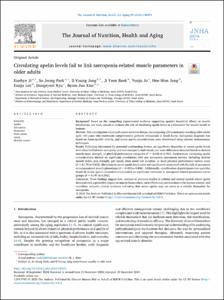GIST Scholar
College of Life Sciences and Medical Engineering
Department of Biomedical Science and Engineering
1. Journal Articles
Circulating apelin levels fail to link sarcopenia-related muscle parameters in older adults
- Type
- Article
- Citation
- Journal of Nutrition, Health and Aging, v.29, no.3
- Issued Date
- 2025-03
- Abstract
- Background: Based on the compelling experimental evidence supporting apelin's beneficial effects on muscle metabolism, our study aimed to evaluate the role of circulating apelin levels as a biomarker for muscle health in humans. Methods: This investigation employed a cross-sectional design, encompassing 237 community-dwelling older adults aged ≥65 years who underwent comprehensive geriatric evaluations in South Korea. Sarcopenia diagnosis was based on Asian-specific criteria, and serum apelin concentrations were determined using enzyme immunoassay techniques. Results: Following adjustment for potential confounding factors, no significant disparities in serum apelin levels were observed between sarcopenic and non-sarcopenic individuals, nor were differences detected based on skeletal muscle mass, strength, or physical performance categories (P = 0.335 to 0.765). Furthermore, circulating apelin concentrations showed no significant correlations with any sarcopenia assessment metrics, including skeletal muscle index, grip strength, gait speed, chair stand test duration, or short physical performance battery score (P = 0.170 to 0.832). Elevations in serum apelin levels were not significantly associated with the risk of sarcopenia or compromised muscle phenotypes (P = 0.452 to 0.896). Additionally, stratification of participants into quartiles based on serum apelin concentrations revealed no significant variations in sarcopenia-related parameters across groups (P = 0.197 to 0.592). Conclusion: These findings suggest that, contrary to previous studies in cellular and animal models where apelin demonstrated a protective impact on muscle homeostasis, such effects may not translate to the human context, and contribute valuable clinical evidence indicating that serum apelin may not serve as a reliable biomarker for sarcopenia. © 2025 The Authors
- Publisher
- Elsevier B.V.
- ISSN
- 1279-7707
- Appears in Collections:
- Department of Biomedical Science and Engineering > 1. Journal Articles
- 파일 목록
-
-
Download
 1_s2.0_S1279770724005657_main.pdf
기타 데이터 / 354.61 kB / Adobe PDF
1_s2.0_S1279770724005657_main.pdf
기타 데이터 / 354.61 kB / Adobe PDF
-
Items in Repository are protected by copyright, with all rights reserved, unless otherwise indicated.